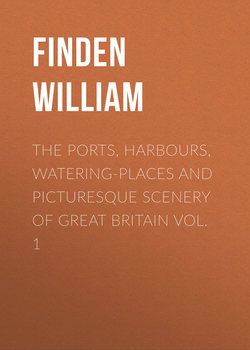Читать книгу The Ports, Harbours, Watering-places and Picturesque Scenery of Great Britain Vol. 1 - Finden William - Страница 5
YARMOUTH QUAY
Оглавление'Twas from the "craft of sail and oar"
That states and kingdoms sprang of yore;
When Commerce ceased to woo the wind,
Their wealth decreased – their power declin'd —
Then, thou who lov'st thy native shore,
Pray Heaven to bless "the sail and oar!"
The subject of the annexed View, representing the Quay at Yarmouth, conveys a faithful idea of that interesting and important locality. It is considered by competent judges as the finest quay in England, and in point of length exceeds every other in the United Kingdom. It is one hundred and fifty yards in breadth, contains in its centre a delightful promenade – planted on each side with trees, protected from the east wind by a row of handsome and well-built houses – and presents in all its aspects a striking combination of commercial activity and ornamental beauty. To the elegant Town Hall, which occupies the centre of this space, and to other public buildings, we have briefly alluded elsewhere. As a grand panorama of commercial life, it would be difficult to point out a finer scene than what is every day presented on the Quay at Yarmouth. Its principal foreign connexion is with the Baltic; and its trade in coal, corn, and other merchandise, coastwise, is very extensive. By means of the navigable rivers Yare, Waveny, and Bure, it possesses great facilities of intercourse with the interior of the county.
In Yarmouth Roads – so renowned for the safe riding they afford to shipping – the anchorage is extensive, and there is room for any number of ships. The Roadstead, however, is better calculated for summer than winter, for to large vessels it is only accessible in the daytime with safety.
The trade for which Yarmouth is peculiarly noted is its fisheries, which are an unfailing source of wealth and employment to the inhabitants, and have proved an invaluable nursery for those hardy and gallant seamen who have so often fought and conquered in the battles of their country. The mackarel1 fishery begins in the end of April, and ends in the beginning of July. The herring2 fishery commences at Michaelmas, and continues till the end of November; during that interval, it affords constant employment to sixteen hundred fishermen, besides six or seven hundred men and women who are engaged in the curing-houses.3 In addition to all these, many others are occupied in the various manufactures connected with the fishery – in the preparation of nets, rope, twine, baskets, coopering, &c.
The number of registered vessels belonging to the Port of Yarmouth is about six hundred, exclusive of fishing-smacks and other small craft. Ship-building is carried on to a great extent; and the artificers in the various departments of the building-yards are considered eminently skilful. There are several private bonding-warehouses, besides that on the South Denes belonging to the Custom-house. On the North Denes are the silk-mills of Messrs. Grout and Co.; and on Cobham Island are considerable salt-works for the use of the town and fisheries. At South Town, or Little Yarmouth, the banks of the Yare – besides the handsome houses by which they are lined on the south – are occupied by docks, timber-wharfs, and shipbuilding-yards, in which a large proportion of the vessels belonging to Yarmouth are constructed and fitted out for sea.
1
Mackarel is found in large shoals, especially on the French and English coasts. This fish enters the English Channel in April, and, as the summer advances, is found on the coasts of Cornwall, Sussex, Normandy, Picardy, &c., where the fishing is most considerable.
2
Herrings are also remarkable as appearing in immense shoals – many miles in extent, and several fathoms in depth. Their presence is easily discovered by the flights of sea-fowl which accompany them, by the unctuous matter with which the water is covered, and in the night by the brilliant phosphoric light which they emit. They are very plentiful about the Orkney Isles in June and July, in the German Ocean in September and October, and in the English Channel in November and December.
3
The London fishmongers are said to prefer the Lowestoff herrings to those cured at Yarmouth, although they are generally retailed under the name of "Yarmouth Herrings."
